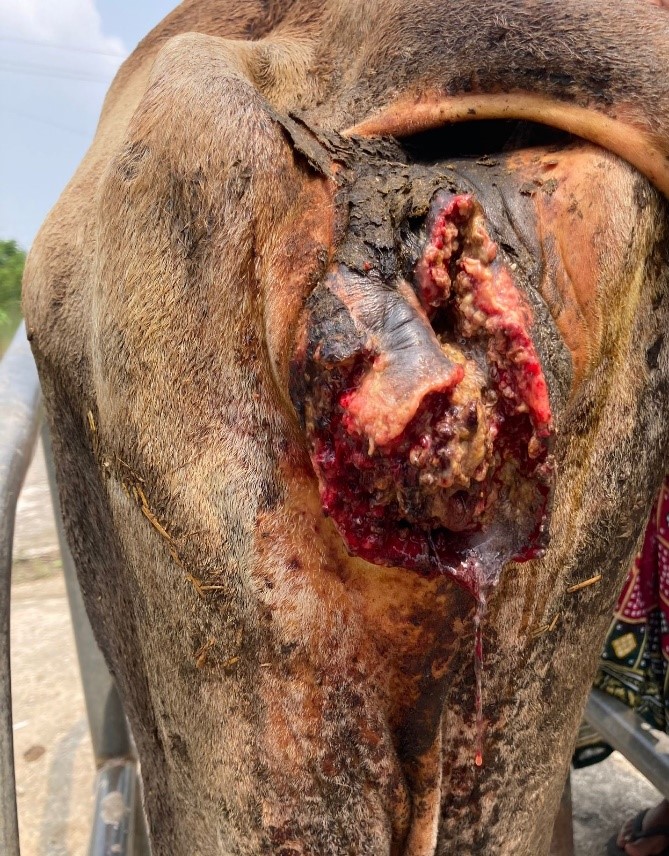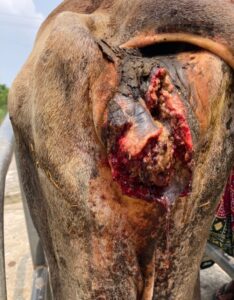Management of maggot wound in livestock
Dr.Tejasvi Meshram, Dr.Tanya pawar, Dr. Neelam Tandia, Dr. Priya Singh
Department of Veterinary Surgery and Radiology, College of Veterinary Science and Animal Husbandry Kuthuliya, Rewa (M.P.)
Nanaji Deshmukh Veterinary Science University Jabalpur (M.P.)
Introduction
Wounds are separation or discontinuity of the skin, mucous membrane, tissue surface caused by physical, chemical or biological causes. Wound are of various kinds – incised, lacerated, punctured, perforating, bites. Skin wounds in domestic livestock could have very adverse effects on health of the animals resulting in dullness, depression, anorexia and other severe health complications which ultimately impairs the productivity of the animals.On worst case scenario these wounds may sometimes become maggoted due to infestation with flies. Different species of flies are associated with Myiasis –
- Lucilia cuprina (Green bottle fly)
- Lucilia sericata
- Calliphora erythrocephala
- Calliphora vomitoria (blue bottle fly)
Lucilia cuprina (Green bottle fly) Calliphora vomitoria (blue bottle fly)
Pic courtesy; David Kennard photography pic courtesy; Melbourne Australia Photos
These flies use wound as a breeding site and deposit their eggs even on the small wounds of the animals. If these injuries remains neglected for long time than the wound may become infested with maggots. Larvae (maggots) hatched out from those eggs which may found sometimes superficial or burrowed deep into the tissues. Maggot wounds becomes more problematic as compared to normal wounds as these maggots feeds on the healthy as well as necrotizing tissues which ultimately enlarge the wound cavity. Later on delays the healing process of the wounds which leads to secondary bacterial infection. The maggot wounds have visibly presence of live or dead maggots. For example some cases like navel ill, injury to the vulva and perineal region and also in delayed expulsion of uterine contents which have foul smell coming from it after parturition generally attracts the flies to feed on it and lay eggs. The images 1 and 2 showing wound on tail and vulvar due to remnant of placental content present on vulvar region resulting in severe maggot infestation.
Picture 1 and 2; Maggot infested wound on tail and vulvar region
Pic courtesy; Veterinary Clinical Complex Kuthuliya, Rewa
Treatment of maggot wounds
- Clean the wound with potassium permanganate solution diluted in plain water, afterwards clean it with an antiseptic povidone iodine solution.
- The maggots on the wound’s surface should be removed with sterile tissue forceps.
- Usually first day of wound management a sterile gauge dipped in Turpentine oil or camphor in oil could be used to compress the wound until next day of the treatment.
- Topical application of inj. ivermectin is also the best way to kill the maggots superficially.
- This process should be repeated until maggots have not been completely removed.
- Carefully debride the necrosed tissues and other cellular debri after complete removal of maggots until next few days. Treat the wound like an open wound, after all maggots have been removed.
- Apply ointment Himax or Lorexane (virbac) on the wound to keep it clean and to fasten the healing process.
- Neem oil, Topicure or Dmag spray could sprayed over the wounded and the surrounding area to keep the flies away.
- The first day of treatment administer – Ecto and endo-parasiticide Inj. Ivermectin
- NSAID Inj.Meloxicam intramuscularly for 5 days.
- Antibiotic Inj.Dicrysticin intramuscularly for seven days, regularly for proper results.
- The wound should be cleaned daily with hydrogen peroxide, Povidone Iodine followed by application of ointment until complete healing.
Conclusion
Wounds attracts the flies due to local unhygienic environment. Neglected wound usually may become maggot infested. Anatomical location of myiasis usually are the navel, vulva, thigh, udder and area between the calws. Highest occurrence is seen in adult animals over 2 years of age as the adult animals may sustain wounds more frequently. Maggot wounds primarily managed by removal of maggots from the wound. Surgical debridement of necrotized tissue should be done properly, this fasten the healing process. Broad spectrum antibiotics should be used to avoid secondary bacterial infections. Use of anti-inflammatory analgesics drugs and anti-parasitic drugs helps to provide early recovery of the wounds. Regular application of ointment and fly repellent drugs should be properly done every day. These aids in fast recovery and prevent further infestation of wound by flies. Treatment of maggot wounds with turpentine oil dressing found most effective.







